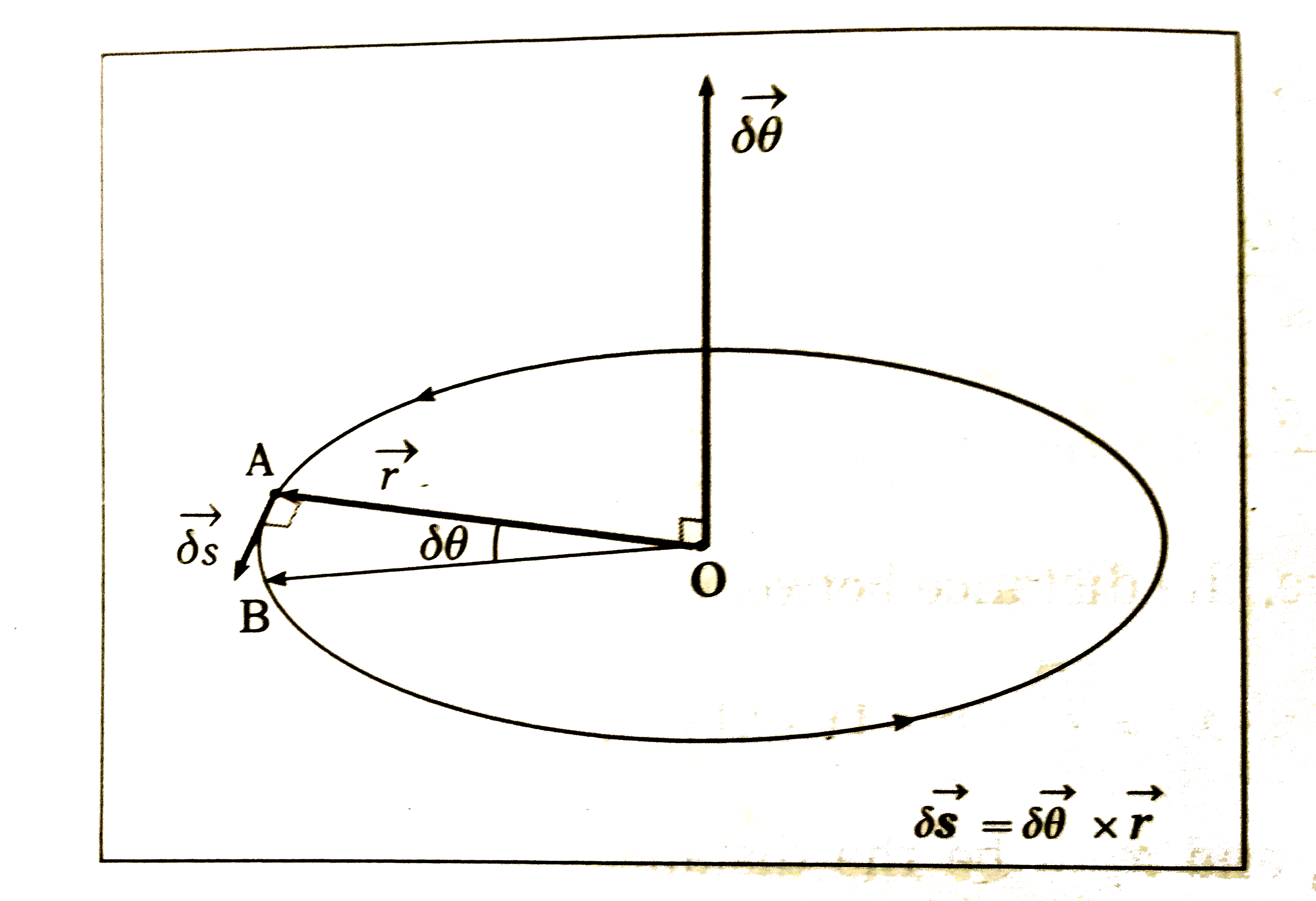Derive the relation between the linear velocity and the angular velocity of a particle in circular motion.
A conical pendulum has length 1 m and the angle made by the string with the vertical is 10∘ . The mass of the bob is 100 g . Find the tension in hte string.
Consider a particle performing circular motion in an anticlockwise sense, along a circle of radius r as shown in the figure. In a very small time interval δt, the particle moves from point A to point B through a distance δs and its angular position changes by δθ.

δθ=arcABradius=δsr
As δt→0, point B will be very close to A and the displacement −−→AB=→δs will be a straight line perpendicular to radius vector −−→OA=→r.
By right hand rule of cross product,
→δs=→δθ×→r
∴limeδt→0→δsδt=⎛⎝limeδt→0→δθδt⎞⎠×→r
∴→dsdt=→dθdt×→r ...(1)
The linear velocity →v of the particle is the time rate of displacement and its angular velocity →ω is the time rate of angular displacement.
∴→v=→dsdtand→ω=→dθdt
Therefore, from Eq. (1) , →v=→ω×→r
Since ds is tangential, the instantaneous linear velocity →v of a particle performing circular motion is along the tangent to the path, in the sense of motion of the particle . →v,→ωand→r are mutually perpendicular, so that in magnitude , v =ωr.
Data : L=1m,θ=10∘,m=0.1kg,g=9.8m/s2
The tension in the string,
F=mgcosθ
=0.1×9.8cos10∘
=0.980.9848=9.89.848
=0.9949 N
log9.8 0.9912log9.848−0.9934––––––––– ¯1.9978––––––––––
AL ¯1.9978=0.9949
Topper's Solved these Questions
- MODEL QUESTION PAPER Book:NAVNEET PUBLICATION - MAHARASHTRA BOARDChapter:MODEL QUESTION PAPER Exercise:SECTION- C
Explore 12 Videos
- LAWS AND THEORIESBook:NAVNEET PUBLICATION - MAHARASHTRA BOARDChapter:LAWS AND THEORIESExercise:Assignments
Explore 2 Videos
- MODEL QUESTION PAPER FOR PRACTICEBook:NAVNEET PUBLICATION - MAHARASHTRA BOARDChapter:MODEL QUESTION PAPER FOR PRACTICEExercise:SECTION-D
Explore 5 Videos
Similar Questions
Knowledge Check
The length of the string of a conical pendulam is 10 m and it has a bob of mass 50 g. The angle that the string makes with the vertical is 30∘. If the bob covers one revolution is 3 s, then the corresponding centripetal force acting on the bob will be
A10 NB1 NC100 ND5 NA pendulum bob of mass m charge q is at rest with its string making an angle θ with the vertical in a uniform horizontal electric field E. The tension in the string in
AmgsinθBmgCqEsinθDqEcosθ
Establish a relation between linear velocity and angular velocity in a uniform circular motion and explain the direction of linear velocity
View SolutionA pendulum bob of mass m and length L is released from angle θ with the vertical. Find
(a) the speed of the bob at the bottom of the swing and
(b) tension in the string at that time
View SolutionA plumb bob of mass 1kg is hung from the ceiling of a train compartment.The train moves on an inclined plane with constant velocity. If the angle of inclined is 30∘.Find the angle made by the string with the normal to the ceiling .Also ,Find the tension in the string (g=10m/s2)
View SolutionA plumb bob of mass 1kg is hung from the ceiling of a train compartment.The train moves on an inclined plane with constant velocity. If the angle of inclined is 30∘.Find the angle made by the string with the normal to the ceiling .Also ,Find the tension in the string (g=10m/s2)
View SolutionA plumb bob of mass 1kg is hung from the ceiling of a train compartment.The train moves on an inclined plane with constant velocity. If the angle of inclined is 30∘.Find the angle made by the string with the normal to the ceiling .Also ,Find the tension in the string (g=10m/s2)
View SolutionA pendulum bob of mass m charge q is at rest with its string making an angle θ with the vertical in a uniform horizontal electric field E. The tension in the string in
View Solution

